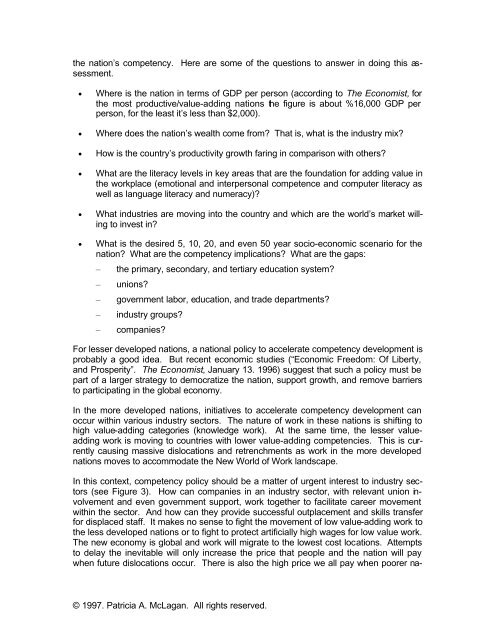Competency systems in the new world of work - McLagan ...
Competency systems in the new world of work - McLagan ...
Competency systems in the new world of work - McLagan ...
You also want an ePaper? Increase the reach of your titles
YUMPU automatically turns print PDFs into web optimized ePapers that Google loves.
<strong>the</strong> nation’s competency. Here are some <strong>of</strong> <strong>the</strong> questions to answer <strong>in</strong> do<strong>in</strong>g this assessment.<br />
• Where is <strong>the</strong> nation <strong>in</strong> terms <strong>of</strong> GDP per person (accord<strong>in</strong>g to The Economist, for<br />
<strong>the</strong> most productive/value-add<strong>in</strong>g nations <strong>the</strong> figure is about %16,000 GDP per<br />
person, for <strong>the</strong> least it’s less than $2,000).<br />
• Where does <strong>the</strong> nation’s wealth come from? That is, what is <strong>the</strong> <strong>in</strong>dustry mix?<br />
• How is <strong>the</strong> country’s productivity growth far<strong>in</strong>g <strong>in</strong> comparison with o<strong>the</strong>rs?<br />
• What are <strong>the</strong> literacy levels <strong>in</strong> key areas that are <strong>the</strong> foundation for add<strong>in</strong>g value <strong>in</strong><br />
<strong>the</strong> <strong>work</strong>place (emotional and <strong>in</strong>terpersonal competence and computer literacy as<br />
well as language literacy and numeracy)?<br />
• What <strong>in</strong>dustries are mov<strong>in</strong>g <strong>in</strong>to <strong>the</strong> country and which are <strong>the</strong> <strong>world</strong>’s market will<strong>in</strong>g<br />
to <strong>in</strong>vest <strong>in</strong>?<br />
• What is <strong>the</strong> desired 5, 10, 20, and even 50 year socio-economic scenario for <strong>the</strong><br />
nation? What are <strong>the</strong> competency implications? What are <strong>the</strong> gaps:<br />
– <strong>the</strong> primary, secondary, and tertiary education system?<br />
– unions?<br />
– government labor, education, and trade departments?<br />
– <strong>in</strong>dustry groups?<br />
– companies?<br />
For lesser developed nations, a national policy to accelerate competency development is<br />
probably a good idea. But recent economic studies (“Economic Freedom: Of Liberty,<br />
and Prosperity”. The Economist, January 13. 1996) suggest that such a policy must be<br />
part <strong>of</strong> a larger strategy to democratize <strong>the</strong> nation, support growth, and remove barriers<br />
to participat<strong>in</strong>g <strong>in</strong> <strong>the</strong> global economy.<br />
In <strong>the</strong> more developed nations, <strong>in</strong>itiatives to accelerate competency development can<br />
occur with<strong>in</strong> various <strong>in</strong>dustry sectors. The nature <strong>of</strong> <strong>work</strong> <strong>in</strong> <strong>the</strong>se nations is shift<strong>in</strong>g to<br />
high value-add<strong>in</strong>g categories (knowledge <strong>work</strong>). At <strong>the</strong> same time, <strong>the</strong> lesser valueadd<strong>in</strong>g<br />
<strong>work</strong> is mov<strong>in</strong>g to countries with lower value-add<strong>in</strong>g competencies. This is currently<br />
caus<strong>in</strong>g massive dislocations and retrenchments as <strong>work</strong> <strong>in</strong> <strong>the</strong> more developed<br />
nations moves to accommodate <strong>the</strong> New World <strong>of</strong> Work landscape.<br />
In this context, competency policy should be a matter <strong>of</strong> urgent <strong>in</strong>terest to <strong>in</strong>dustry sectors<br />
(see Figure 3). How can companies <strong>in</strong> an <strong>in</strong>dustry sector, with relevant union <strong>in</strong>volvement<br />
and even government support, <strong>work</strong> toge<strong>the</strong>r to facilitate career movement<br />
with<strong>in</strong> <strong>the</strong> sector. And how can <strong>the</strong>y provide successful outplacement and skills transfer<br />
for displaced staff. It makes no sense to fight <strong>the</strong> movement <strong>of</strong> low value-add<strong>in</strong>g <strong>work</strong> to<br />
<strong>the</strong> less developed nations or to fight to protect artificially high wages for low value <strong>work</strong>.<br />
The <strong>new</strong> economy is global and <strong>work</strong> will migrate to <strong>the</strong> lowest cost locations. Attempts<br />
to delay <strong>the</strong> <strong>in</strong>evitable will only <strong>in</strong>crease <strong>the</strong> price that people and <strong>the</strong> nation will pay<br />
when future dislocations occur. There is also <strong>the</strong> high price we all pay when poorer na-<br />
© 1997. Patricia A. <strong>McLagan</strong>. All rights reserved.


